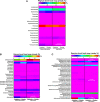Adjuvant Probiotics of Lactobacillus salivarius subsp. salicinius AP-32, L. johnsonii MH-68, and Bifidobacterium animalis subsp. lactis CP-9 Attenuate Glycemic Levels and Inflammatory Cytokines in Patients With Type 1 Diabetes Mellitus
- PMID: 35299968
- PMCID: PMC8921459
- DOI: 10.3389/fendo.2022.754401
Adjuvant Probiotics of Lactobacillus salivarius subsp. salicinius AP-32, L. johnsonii MH-68, and Bifidobacterium animalis subsp. lactis CP-9 Attenuate Glycemic Levels and Inflammatory Cytokines in Patients With Type 1 Diabetes Mellitus
Abstract
Introduction: Type 1 diabetes mellitus (T1DM) is characterized by autoimmune destruction of pancreatic β cells. Previous study has discovered that probiotic strains residing in the gut play essential roles in host immune regulation. However, few clinical results demonstrated probiotic would actually benefit in attenuating glycated hemoglobin (HbA1c) along with inflammatory cytokine levels of the T1DM patients and analyzed their gut microbiota profile at the same time. In this clinical trial, we evaluated the therapeutic efficacy of probiotics on HbA1c along with inflammatory cytokine levels of T1DM patients to determine an alternative administration mode for T1DM medication. The probiotics changed T1DM gut microbiota profile will be measured by next-generation sequencing (NGS).
Research design and methods: A randomized, double-blind, placebo-controlled trial was performed at China Medical University Hospital. T1DM patients between 6 and 18 years of age were enrolled. 27 patients were administered regular insulin therapy plus capsules containing probiotic strains Lactobacillus salivarius subsp. salicinius AP-32, L. johnsonii MH-68, and Bifidobacterium animalis subsp. lactis CP-9 daily for 6 months, and 29 patients were administered insulin therapy without extra probiotic supplement as placebo group. The variations of fasting blood glucose and HbA1c in these patients were analyzed. In addition, serum levels of inflammatory cytokines and anti-inflammatory cytokine were assessed using enzyme-linked immunosorbent assay. Patients' stool microbiota were all subjects to NGS analysis.
Results: NGS data showed elevated populations of Bifidobacterium animalis, Akkermansia muciniphila and Lactobacillus salivarius in the gut of patients with T1DM who were taking probiotics. Patients with T1DM who were administered probiotics showed significantly reduced fasting blood glucose levels compared with the before-intervention levels. The HbA1c levels of the patients also improved after administration of probiotics. The concentrations of IL-8, IL-17, MIP-1β, RANTES, and TNF-α were significantly reduced and were associated with an increased TGF-β1 expression after probiotic intervention. The persistence effect of glycemic control and immunomodulation were observed even 3 months after discontinuation of the probiotics.
Conclusions: Here, we found that conventional insulin therapy plus probiotics supplementation attenuated T1DM symptoms than receiving insulin treatment only. Probiotics supplementation with insulin treatment changed gut microbiota and revealed better outcome in stabilizing glycemic levels and reducing HbA1c levels in patients with T1DM through beneficial regulation of immune cytokines.
Clinical trial registration: ClinicalTrials.gov, identifier NCT03880760.
Keywords: T1DM; glycemic levels; gut microbiota; immune cytokines; probiotic.
Copyright © 2022 Wang, Yen, Lu, Ho, Lin, Kuo, Huang, Tsai and Lin.
Conflict of interest statement
Author H-HH, W-YL, Y-WK, Y-YH, and S-YT were employed by Bioflag Biotech Co., Ltd. The remaining authors declare that the research was conducted in the absence of any commercial or financial relationships that could be construed as a potential conflict of interest.
Figures


Similar articles
-
Assessment of the safety and gut microbiota modulation ability of an infant formula containing Bifidobacterium animalis ssp. lactis CP-9 or Lactobacillus salivarius AP-32 and the effects of the formula on infant growth outcomes: insights from a four-month clinical study in infants under two months old.BMC Pediatr. 2024 Dec 27;24(1):840. doi: 10.1186/s12887-024-05289-7. BMC Pediatr. 2024. PMID: 39731060 Free PMC article. Clinical Trial.
-
A Three-Arm, Randomized, Double-Blind, Placebo-Controlled Study to Evaluate the Safety of Lactobacillus salivarius AP-32 and Bifidobacterium animalis CP-9 Used Individually in Healthy Infants.Nutrients. 2023 Aug 2;15(15):3426. doi: 10.3390/nu15153426. Nutrients. 2023. PMID: 37571365 Free PMC article. Clinical Trial.
-
Multi-strain probiotic supplement attenuates streptozotocin-induced type-2 diabetes by reducing inflammation and β-cell death in rats.PLoS One. 2021 Jun 24;16(6):e0251646. doi: 10.1371/journal.pone.0251646. eCollection 2021. PLoS One. 2021. PMID: 34166387 Free PMC article.
-
Bifidobacterium animalis subsp. lactis 420 for Metabolic Health: Review of the Research.Nutrients. 2020 Mar 25;12(4):892. doi: 10.3390/nu12040892. Nutrients. 2020. PMID: 32218248 Free PMC article. Review.
-
Meta-analysis of randomized controlled trials of the effects of probiotics on type 2 diabetes in adults.Clin Nutr. 2022 Feb;41(2):365-373. doi: 10.1016/j.clnu.2021.11.037. Epub 2021 Dec 10. Clin Nutr. 2022. PMID: 34999331
Cited by
-
Research progress of diabetic retinopathy and gut microecology.Front Microbiol. 2023 Sep 7;14:1256878. doi: 10.3389/fmicb.2023.1256878. eCollection 2023. Front Microbiol. 2023. PMID: 37744925 Free PMC article. Review.
-
The Effect of Microbiome-Modulating Agents (MMAs) on Type 1 Diabetes: A Systematic Review and Meta-Analysis of Randomized Controlled Trials.Nutrients. 2024 May 29;16(11):1675. doi: 10.3390/nu16111675. Nutrients. 2024. PMID: 38892608 Free PMC article.
-
Microbial regulation of offspring diseases mediated by maternal-associated microbial metabolites.Front Microbiol. 2022 Nov 4;13:955297. doi: 10.3389/fmicb.2022.955297. eCollection 2022. Front Microbiol. 2022. PMID: 36406399 Free PMC article. Review.
-
Impact of gut-peripheral nervous system axis on the development of diabetic neuropathy.Mem Inst Oswaldo Cruz. 2023 Mar 20;118:e220197. doi: 10.1590/0074-02760220197. eCollection 2023. Mem Inst Oswaldo Cruz. 2023. PMID: 36946851 Free PMC article.
-
The Gut Microbiota: A Novel Player in Autoimmune Hepatitis.Front Cell Infect Microbiol. 2022 Jul 11;12:947382. doi: 10.3389/fcimb.2022.947382. eCollection 2022. Front Cell Infect Microbiol. 2022. PMID: 35899041 Free PMC article. Review.
References
-
- Dokken BB. The Pathophysiology of Cardiovascular Disease and Diabetes: Beyond Blood Pressure and Lipids. Diabetes Spectr (2008) 21(3):160–5. doi: 10.2337/diaspect.21.3.160%JDiabetesSpectrum - DOI
Publication types
MeSH terms
Substances
Associated data
LinkOut - more resources
Full Text Sources
Medical
Miscellaneous

